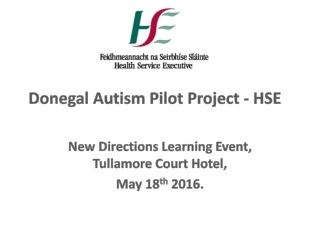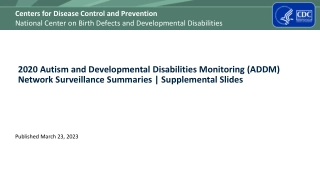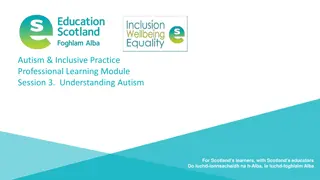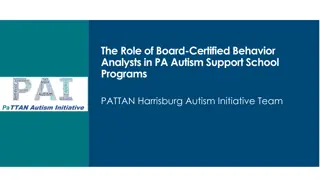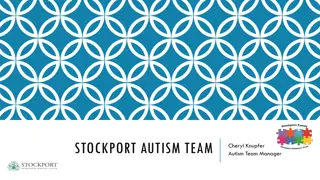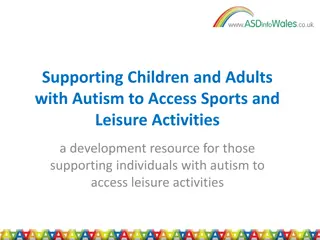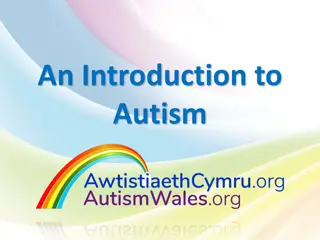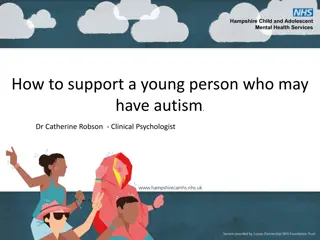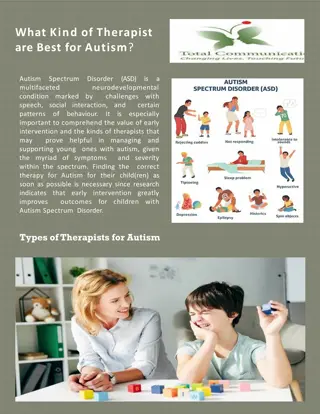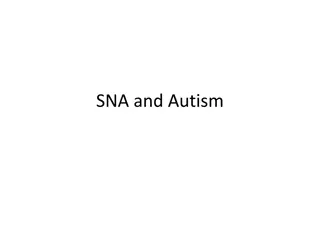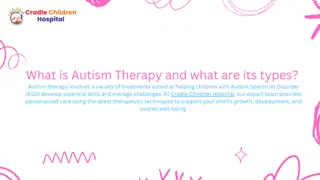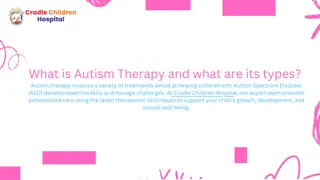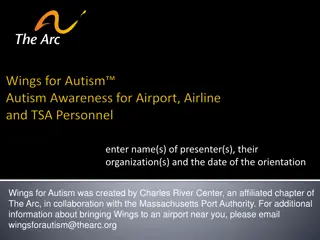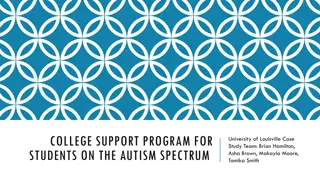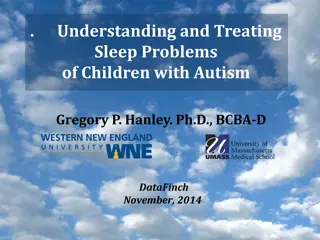
Evolution of DSM and Diagnostic Criteria for Autism Spectrum Disorder
Explore the history of the Diagnostic and Statistical Manual of Mental Disorders (DSM) from its origins in the 1840 Census to the latest DSM-5 in 2013. Learn about the development of diagnostic criteria, including the detailed assessment for Autism Spectrum Disorder (ASD) focusing on social communication deficits, nonverbal behaviors, and repetitive patterns of behavior.
Download Presentation

Please find below an Image/Link to download the presentation.
The content on the website is provided AS IS for your information and personal use only. It may not be sold, licensed, or shared on other websites without obtaining consent from the author. If you encounter any issues during the download, it is possible that the publisher has removed the file from their server.
You are allowed to download the files provided on this website for personal or commercial use, subject to the condition that they are used lawfully. All files are the property of their respective owners.
The content on the website is provided AS IS for your information and personal use only. It may not be sold, licensed, or shared on other websites without obtaining consent from the author.
E N D
Presentation Transcript
HISTORY OF THE DSM 1840 Census asks info about family idiocy insanity 1880 Census -7 categories of mental illness Mania, melancholia, monomania, paresis, dementia, dipsomania, epilepsy 1921 American Psychological Association formed and with the NY Academy of Medicine publishes the Standard Classification Nomenclature of Disease
History of DSM continued 1950s WHO works on ICD 6 and APA on a Diagnostic and Statistics Manual (DSM) in close collaboration. 1952 DSM Published. 1965 DSM II 1980 DSM III 1987 DSM III R To make minor changes and corrections to DSMIII
History of DSM 1994 DSM IV made a significant attempt to avoid diagnoses that were just theory based and base diagnosis on observable events/characteristics. 2013 DSM-5. Large effort to involve many academics and practicing psychiatrists. Definitions field tested and revised.
Diagnostic Criteria for 299.00 Autism Spectrum Disorder A. Persistent deficits in social communication and social interaction across multiple contexts, as manifested by the following, currently or by history (examples are illustrative, not exhaustive; see text): 1.Deficits in social-emotional reciprocity, ranging, for example, from abnormal social approach and failure of normal back-and-forth conversation; to reduced sharing of interests, emotions, or affect; to failure to initiate or respond to social interactions.
Social communication and interaction (cont.) 2.Deficits in nonverbal communicative behaviors used for social interaction, ranging, for example, from poorly integrated verbal and nonverbal communication; to abnormalities in eye contact and body language or deficits in understanding and use of gestures; to a total lack of facial expressions and nonverbal communication. 3.Deficits in developing, maintaining, and understand relationships, ranging, for example, from difficulties adjusting behavior to suit various social contexts; to difficulties in sharing imaginative play or in making friends; to absence of interest in peers. Specify current severity: Severity is based on social communication impairments and restricted, repetitive patterns of behavior
Restricted, repetitive patterns of behavior B.Restricted, repetitive patterns of behavior, interests, or activities, as manifested by at least two of the following, currently or by history (examples are illustrative, not exhaustive; see text): 1.Stereotyped or repetitive motor movements, use of objects, or speech (e.g., simple motor stereotypes, lining up toys or flipping objects, echolalia, idiosyncratic phrases).
Restricted repetitive cont. C.Symptoms must be present in the early developmental period (but may not become fully manifest until social demands exceed limited capacities, or may be masked by learned strategies in later life). D.Symptoms cause clinically significant impairment in social, occupational, or other important areas of current functioning. E.These disturbances are not better explained by intellectual disability (intellectual developmental disorder) or global developmental delay. Intellectual disability and autism spectrum disorder frequently co- occur; to make comorbid diagnoses of autism spectrum disorder and intellectual disability, social communication should be below that expected for general developmental level.
Restricted pattern of behavior (cont.) 2.Insistence on sameness, inflexible adherence to routines, or ritualized patterns of verbal or nonverbal behavior (e.g., extreme distress at small changes, difficulties with transitions, rigid thinking patterns, greeting rituals, need to take same route or eat same food every day). 3.Highly restricted, fixated interests that are abnormal in intensity or focus (e.g., strong attachment to or preoccupation with unusual objects, excessively circumscribed or perseverative interests). 4.Hyper- or hyporeactivity to sensory input or unusual interest in sensory aspects of the environment (e.g. apparent indifference to pain/temperature, adverse response to specific sounds or textures, excessive smelling or touching of objects, visual fascination with lights or movement). Severity is based on social communication impairments and restricted, repetitive patterns of behavior.
Note: Individuals with a well-established DSM-IV diagnosis of autistic disorder, Asperger s disorder, or pervasive developmental disorder not otherwise specified should be given the diagnosis of autism spectrum disorder. Individuals who have marked deficits in social communication, but whose symptoms do not otherwise meet criteria for autism spectrum disorder, should be evaluated for social (pragmatic) communication disorder.
Level 3 "Requiring very substantial support communication. Level 3 "Requiring very substantial support Severe deficits in verbal and nonverbal social communication skills cause severe impairments in functioning, very limited initiation of social interactions, and minimal response to social overtures from others. For example, a person with few words of intelligible speech who rarely initiates interaction and, when he or she does, makes unusual approaches to meet needs only and responds to only very direct social approaches
Level 3 requiring very substantial support behavior Inflexibility of behavior, extreme difficulty coping with change, or other restricted/repetitive behaviors markedly interfere with functioning in all spheres. Great distress/difficulty changing focus or action.
Level 2 requiring substantial support "Requiring substantial support Marked deficits in verbal and nonverbal social communication skills; social impairments apparent even with supports in place; limited initiation of social interactions; and reduced or abnormal responses to social overtures from others. For example, a person who speaks simple sentences, whose interaction is limited to narrow special interests, and how has markedly odd nonverbal communication.
Level 3 behavior Inflexibility of behavior, extreme difficulty coping with change, or other restricted/repetitive behaviors markedly interfere with functioning in all spheres. Great distress/difficulty changing focus or action. Inflexibility of behavior causes significant interference with functioning in one or more contexts. Difficulty switching between activities. Problems of organization and planning hamper independence.
Level 2 requiring substantial support communication Marked deficits in verbal and nonverbal social communication skills; social impairments apparent even with supports in place; limited initiation of social interactions; and reduced or abnormal responses to social overtures from others. For example, a person who speaks simple sentences, whose interaction is limited to narrow special interests, and how has markedly odd nonverbal communication.
Level 2 requiring substantial support behaviors Inflexibility of behavior, difficulty coping with change, or other restricted/repetitive behaviors appear frequently enough to be obvious to the casual observer and interfere with functioning in a variety of contexts. Distress and/or difficulty changing focus or action.
Level 1 Requiring support Verbal and communication Without supports in place, deficits in social communication cause noticeable impairments. Difficulty initiating social interactions, and clear examples of atypical or unsuccessful response to social overtures of others. May appear to have decreased interest in social interactions. For example, a person who is able to speak in full sentences and engages in communication but whose to- and-fro conversation with others fails, and whose attempts to make friends are odd and typically unsuccessful.
Level 1 requiring support behavior Inflexibility of behavior causes significant interference with functioning in one or more contexts. Difficulty switching between activities. Problems of organization and planning hamper independence.
Finding Autism Ask every parent if they have any concerns about how their child is developing, learning or behaving. Listen to the response. If the concern is language , explore the child s behaviors.
MCHAT-R/F MCHAT- one of the best screening devices for autism. To be used in all kids at 2 or so. If R is positive, the follow up form will help decrease unneeded referrals. If any suspicions, refer immediately to Early Intervention whether or not you refer for specialist diagnostic eval.
Who can Make a diagnosis of Autism? Nothing in the DSM 5 says anything about that. We get referrals from schools all the time and frequently autism is listed. School classification is not the same as medical diagnosis. To get certain services, need appropriate specialist.
Childrens Autism Center Diagnostic challenges are common. Typically 3 specialists from Neurology, Psychology and Developmental Peds plus social worker. Prevents need for 3 separate visits. We need significant prior info. Medical and family history, school information including psych testing and IEP.
Childrens Autism Center. We use the Social Communication Questionnaire (SCQ) if child is 4 +. Score above 14 is suggestive but NOT diagnostic of Autism. Teacher Social Responsiveness Scale also helpful but not diagnostic. Each of us does our own evaluation and we confer after clinic. We use ADOS to confirm if disagreement.
About the ADOS* The Autism Diagnostic Observation Schedule (ADOS) is a semi-structured assessment of communication, social interaction, and play (or imaginative use of materials) for individuals suspected of having autism or other pervasive developmental disorders. The ADOS consists of four modules, each of which is appropriate for children and adults of differing developmental and language levels, ranging from nonverbal to verbally-fluent.
OPWDD Although the DSM 5 says nothing about using standardized tests for diagnosis, the diagnosis of Autism in NYS makes some services available to families. OPWDD does require either an ADOS or the CARS and a measure of function such as a Vineland or ABAS to qualify for services.


